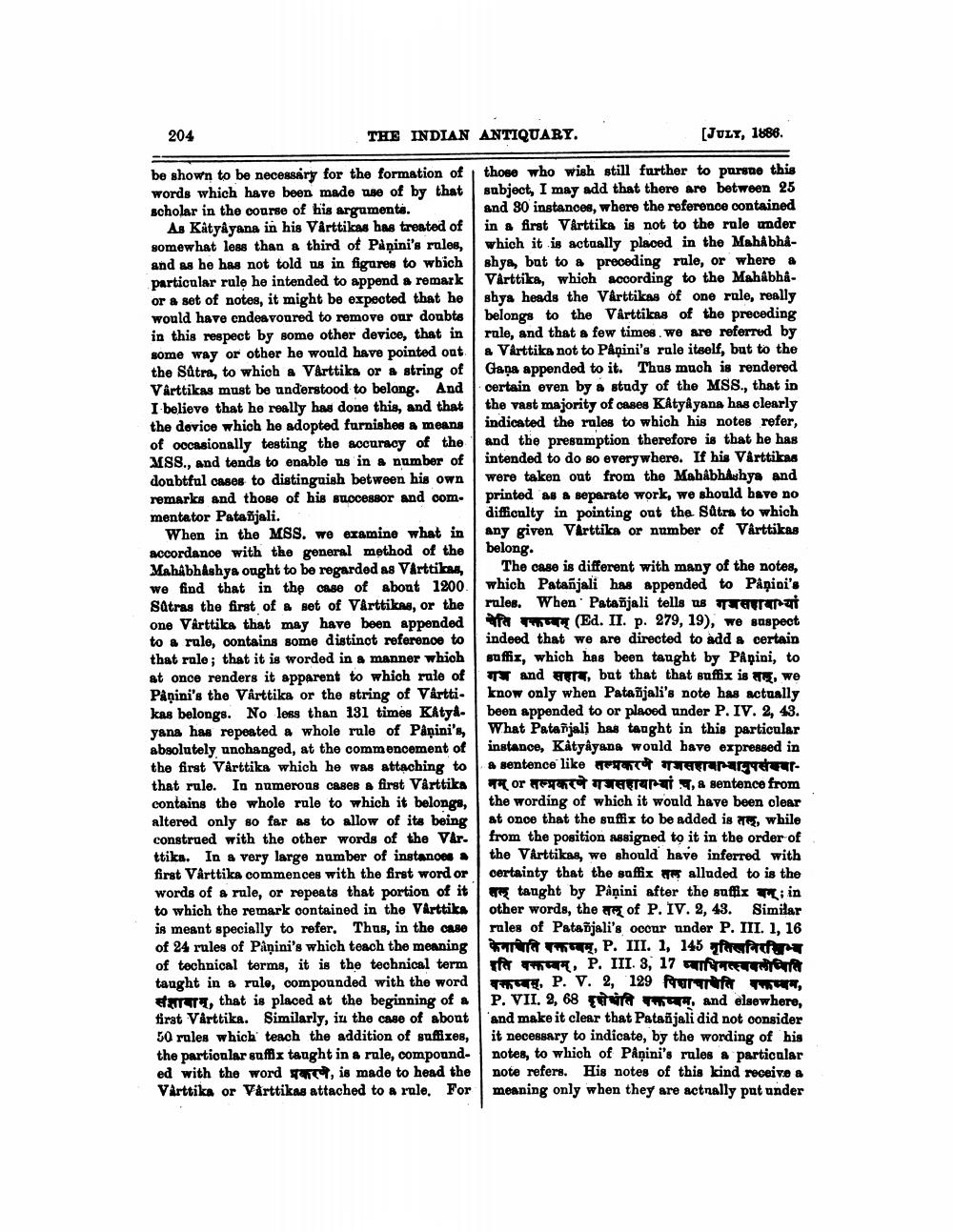________________
204
THE INDIAN ANTIQUARY.
(JULY, 1886.
be shown to be necessary for the formation of those who wish still further to pursue this words which have been made use of by that subject, I may add that there are between 25 scholar in the course of his arguments. and 80 instances, where the reference contained
As Katyâyana in his Vårttikas has treated of in a first Vårttika is not to the rule under somewhat less than a third of Påņini's rules, which it is actaally placed in the Mahâbhiand as he has not told ns in figures to wbich shya, bat to a preceding rule, or where a particular rulo he intended to append a remark Vårttika, which according to the Mahabhaor a set of notes, it might be expected that he shya heads the Vårttikas of one rule, really would have endeavoured to remove our doubts belongs to the Varttikas of the preceding in this respect by some other device, that in rule, and that a few times. We are referred by some way or other he would have pointed out a Vårttika not to PÅņini's role itself, but to the the Satra, to which a Varttiks or a string of Gana appended to it. Thus mach is rendered Vårttikas must be understood to belong. And certain even by a study of the MSS., that in I believe that he really has done this, and that the vast majority of cases KÅtyâyana has clearly the device which he adopted furnishes a means indicated the rules to which his notes refer, of occasionally testing the accuracy of the and the presumption therefore is that he has MSS., and tends to enable us in a number of intended to do so everywhere. If his Vårttikas doubtful cases to distinguish between his own were taken out from the Mahabhashya and remarks and those of his successor and com- printed as a separate work, we should bave no mentator Patañjali.
difficulty in pointing out the Satra to which When in the MSS. we examine what in any given Varttika or number of Varttikas accordance with the general method of the belong. Mahabhashya ought to be regarded as Varttikas, The case is different with many of the notes, we find that in the case of about 1200 which Patanjali has appended to Påņini's Sätras the first of a set of Varttikas, or the rules. When Patanjali tells us Terrat one Arttika that may have been appended farmer (Ed. II. p. 279, 19), we suspect to a rule, contains some distinot reference to indeed that we are directed to add a certain that rale; that it is worded in a manner which suffir, which has been taught by PÅpini, to at once renders it apparent to which rule of | गण and सहाब, but that that suffix isa, we Påņini's the Värttika or the string of Vårtti. know only when Patañjali's note has actually kas belongs. No less than 131 times Katy- been appended to or placed under P. IV. 2, 43. yana has repeated & whole rule of Panini's, What Patañjali has taught in this particular absolutely unchanged, at the commencement of instance, Kâtyâyana would have expressed in the first Varttiks which he was attaching to a sentence like to
arranger that rule. In numerous cases a first Vårttika Tor T erra, a sentence from contains the whole rule to which it belongs, the wording of which it would have been clear altered only so far as to allow of its being at once that the suffix to be added is , while construed with the other words of the Var. from the position assigned to it in the order of
ika. In a very large number of instances the Varttikas, we should have inferred with first Vårttika commences with the first word or certainty that the saffis alluded to is the words of a rule, or reports that portion of it are taught by Panini after the suffix : in to which the remark oontained in the Varttiks other words, the roof P.IV.2, 43. Similar is meant specially to refer. Thus, in the case rules of Patañjali's occur ander P. III. 1, 16 of 24 rules of Paņini's which teach the meaning
P. III. 1, 145 frafas of technical terms, it is the technical term form , P. III. 3, 17 taught in a rule, compounded with the word T rg, P. V. 2, 129 RON
, HTT, that is placed at the beginning of a P. VII. 2, 68
and elsewhere, first Vårttika. Similarly, in the case of about and make it clear that Patañjali did not consider 50 rules which teach the addition of suffixes, it necessary to indicate, by the wording of his the particular suffix taught in a rule, compound- notes, to which of Påņini's rules a particular ed with the word is made to head the note refers. His notes of this kind receive a Varttika or Vårttikas attached to a rale. For meaning only when they are actnally put under




